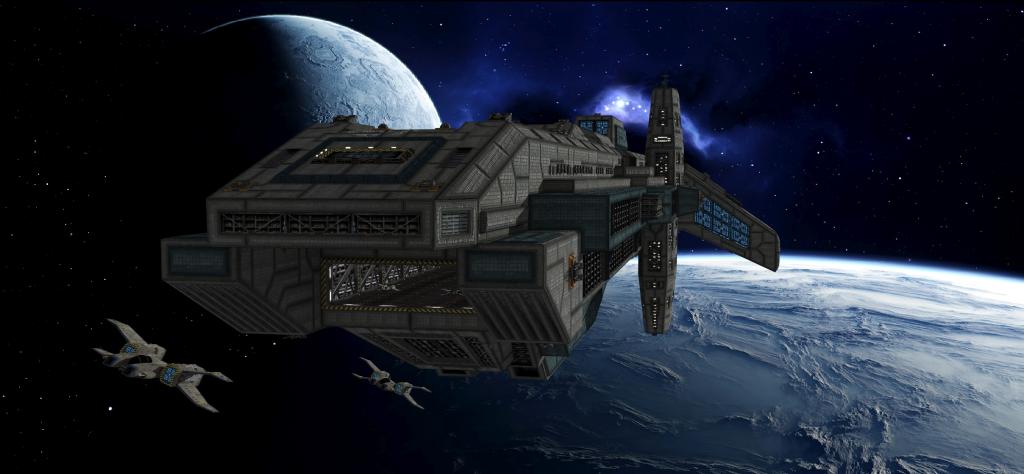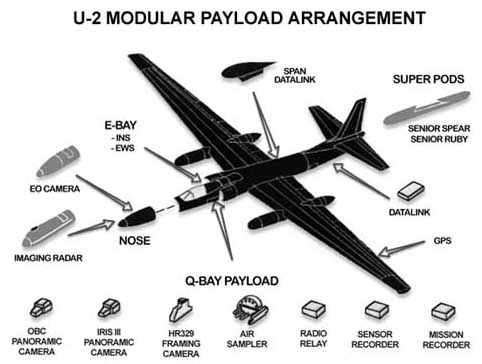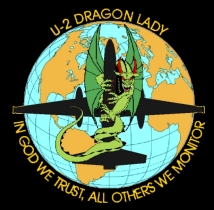
Lackland Station herself. | U-2 Dragonlady Spy Plane. | 
Lackland Station herself. |
|---|
| U-2 Dragonlady Spy Plane: |
|---|
 |  | | A U-2 Dragonlady in a semi-exploded view. |
|---|
| Name: | U-2 Dragonlady. |
|---|
| Model Type: | Reconnaissance. |
|---|
| Crew: | One or two. |
|---|
| Passengers: | None. | A U-2 Squadron Patch. |
|---|
Despite it's inherent greatness, the SR-71 Blackbird does have one great drawback; It's cost. At 100,000 credits each for the U-2 vs. 25 million credits each for the SR-71, the cost difference is QUITE considerable; The non-stealth U-2 Dragonfly spy plane requires only 1 hour to be airborne, compared to the SR-71's minimum 16 hours to airborne; And only requires ONE person to operate.However, the U-2 has it's OWN critics: The U-2 in non-stealth, so it is inherently observable; It's FAR slower (sub-sonic); And, at roughly equal operational cost, it's not as flexible, as it can not accommodate ANY kind of armaments. However, the UGC keeps both in inventory, as the 2 aero-space craft make good COMPLEMENTS to one another.Like the Blackbird, myth and rumor surrounds this plane, some of it true, most not, others partly. Unlike the Blackbird, though, the U-2 is available to civilians; They have been used to takes pics of territory, for civilian engineering, mining, agriculture, etc purposes. Each pic desired costs about 25,000 credits to produce and is available in 1 day for MOST projects.The Chameleon Visible Wavelength Observation Limiting System, hexagonal pleizio-ceramic tiles mounted to the skin of the craft can be darkened or lightened as necessary to render the craft, for all intents and purposes, invisible, is available for militry and Galactic Charting Services U-2 (GCS is a militry agency). The further away the viewer is to the craft, the greater the distortion, making it harder and harder to see. At a range of only a half mile the craft becomes effectively invisible. The system only produces white light; Though coloring the lights IS possibly, in practical use it proved to enhance to planes profile, making it easier to see, rather than harder. This is NOT available to civilian U-2's, however.The U-2 also has gained a new feature: The space-drop re-entry shield. It's essentially a modified DS-2 Full-Force Barrier Field which protects the underside of the craft during reentry. Once the craft is inside the atmosphere, the grav pods keep it aloft. Note: The wings must be folded up when the U-2 is entering the atmosphere.Finally, the U-2 has gained from one other new aspect; Piggybacking on either the SR-71 Blackbird or XB-71 Aurora, giving it effectively inter-stellar capability in co-operation with these longer-ranged aero-spacecraft.Name: U-2 DragonladyModel Type: ReconnaissanceCrew: One or two.Passengers: None.MDC By Location: |
Fuselage-
Cockpit-
Wings (2)- | 200
100
100 each | Tailerons (2)-
Tail Rudder-
Variable Thrusters (2)- | 60 each
60 each
100 each |
| Speed and Statistical Data: |
In the air: 500 MPH
Range in the air: 80,000 miles. Can be refueled in the air.
On the ground: 10 MPH
Range on the ground: 100 miles max.
Height: 16 feet 1 inches
Wingspan:Wings Extended: 103 ftWings Folded Against the Fuselage: 30 feet, 2 inches
Length: 62 feet 9 inches
Weight: 20.5 tons
Cargo: Only the pilot's emergence supplies can be carried. | Power/Thrust System: One MRC-10n Hydro-Cell Jet Engines Thrust: 20,000 lb
Flight Systems:Primary: Grav PodsSecondary: Normal Aero-Foil effect and Hydro-Cell Jets.
Cost: 100,000 credits new and unarmed.
Availability: Every 3 months another batch of 10 becomes available.
Black Market Cost: An equivalent system would cost between 25, and 30 million credits, depending on buyer and seller.
Black Market Availability: An equivalent jet powered system COULD be made available, but it would be VERY rare, and would not have anti-grav capability, for an estimated cost of between 50,000 and 5 million credits, depending on buyer and seller.
|
| Weapons SystemsNONE: This is NOT a combat aircraft. |
| Features: |
- ESM: Radar Detector. Passively detects other radars being operated.
- Radar: Combat grade radar. Range 100 miles, can track up to 50 individual targets. 95% reliability (24% against unfriendly stealthed vehicles).
- Blue Force Tracker: Identifies friend from foe. Overlays the information on both the radar and HUD, ensuring that friendly forces are not accidentally targeted.
- GPS: Standard tracking device. Ties into the Blue Force Tracker.
- Anti-Jamming System: Reduces Electronics Countermeasure by ¾ (decrease skill level appropriately).
- HUD: Displays maps, radar, targeting information, and any OTHER information the wearer wants directly in front of the user.
- FLIR/SLIR: Forward and Side Looking Infrared. Allows pilot to get visuals on targets at night.
- AJP: Active Jamming Pod. Causes -25% to detection but when it is active, other vehicles/bases can detect that it is jamming, and some missiles will home in on jamming signals. Jamming also causes a -4 penalty to all radar guided weapons. The jamming pod is only mounted inside the port taileron.
- AMC/FD (2): Anti-Missile Chaff/Flare Dispensers. Actually launches a glob of burning magnesium/aluminum alloy to confuse both radar AND heat sensory systems. Fires off 04 chaff/flares each time it is activated. The system is KNOWN to work on all KNOWN radar and infrared systems, but concerns continue that somewhere out there their MIGHT be a system that will be totally unaffected by the system. Reduce effects by 20% against smart missiles (add +20% to rolls for smart missiles).
- Effect:
- 01-50 Enemy missile or missile volley detonates in chaff cloud- Missiles are all destroyed.
- 51-75 Enemy missile or missile volley loses track of real target and veers away in wrong direction (may lock onto another target).
- 76-00 No effect, missile is still on target.
- Also note that the chaff cloud will also blind nearby heat sensors (and optically based sensors at night) for 1 melee. They will suffer the following penalties: Reduce melee attacks/actions, and combat bonuses by half.
- Duration: 1D4 melee rounds.
- Payload: 60 chaff/flares. Each time the system is engaged, the system fires off 04 chaff/flares.
- LDP (4): Launched Decoy Pods. Located on the ventral side of the fuselage, the satellite carries advanced decoy drones, specially designed radar lure that creates a radar image to mimic the satellite. The drones are launched and fly off in various directions away from the satellite. Each is a specially. The decoys self-destruct at random times (multiples of 30 minutes, i.e. 30 minutes later, 60 minutes later, 90 minutes later, etc). This system has been successfully deployed against SEVERAL alien radar-type sensors (including one that works off of sound), but not against Invid Protoculture sensors. (They will sometimes attract Invid, however, at -50%.)
- MDC: 5
- Effects: The decoy has a 98% chance of fooling ordinary non militry radars and non smart guided missiles, and a 90% chance of fooling militry grade radars and advanced smart missiles.
- Range: Released to go wherever it wants. Can fly independently for about 30 minutes.
- Rate of Fire: 2 every melee.
- Payload: 16 Decoys each pod.
| - Virtual Map: Displays a continuously-updating map of local terrain for the pilot. Takes data from and gives data to other friendly units in the area. Effective land navigation of 85% as updates come. Good to 500 miles. Specific range can be adjusted in 1 mile increments.
- Video Camera: Records from the HUD. 50 hours of recording available.
- Full range optic sensory suite: Infrared, ultra violet, Magnification, night sight, color filters, thermal imager. Range is about 200 miles for MOST sensors.
- Telescoping Arms: The U-2 is equipped with a telescoping Canadarm with a reach of 6 feet. This is one of the VERY few aircraft that has manipulator arms, and is typically used to repair and/or service CS/A-013(a) Satellites. They CAN also be used by more aggressive pilots to recover high-profile samples.
- Survival Pack: A pack of simpler emergency survival supplies: Pup tent, sleeping bag, black light, GPS, first aid kit (bandages, gauze, bandage tape, pads, antiseptic/analgesic), plasma torch (for small repairs and starting fires), repair kit (with MDC Repair Spray), sewing kit (a small spool of thread and 5 needles), 7 star flares (250 foot apogee), 2 white parachute flares (1,500 foot apogee), 100 feet of black or brown parachute cord (150 lbs tensile strength), 2-5 days rations, 2 gallons water, water purification kit- good for about 10 gallons.
- Sensory Systems: The craft is equipped with sensors the likes of which no one has ever before imagined; Laser sensors that can listen in on spoken conversations, in crowded and noise-filled places; Cameras that can read the seconds on a digital wrist-watch in the dark; Signal interceptor systems that can not only eavesdrop on laser-secured radio systems, but in fact can even JAM them, causing a totally worthless signal to be received; Even a EMP-based dampening system that can tap into computers, copying all the data and leaving a blank computer in it's wake (unfortunately this does not work on hardened circuitry); Magnetic Resonance Imaging systems that can tell not only when one object is hiding amongst others (such as a power armor hiding in thick foliage with it's power plant off), but even near-alike objects intertwined (such as two different types of plants growing together); All from the edge of space.
- Smoke dispensers (8): Throws out smoke flares capable of obscuring IR and heat sensors, and defeats visual tracking of the vehicle. Mostly used to cover landing and takeoffs.
- Chameleon System: Pleizio-ceramic tiles darkened or lightened as necessary to render the craft invisible.
Minimum Effective Distance: 2,910 feet. - Space-Drop Reentry Shield: Essentially a modified DS-2 Full-Force Barrier Field which protects the underside of the craft during reentry. Once the craft is inside the atmosphere, the grav pods keep it aloft.
|
Combat Bonuses from U-2 Dragonfly Combat Elite:- 4 additional attack per melee.
- One additional Attack Per melee at levels 3, 6, 9, 12, and 15 with any additional bonuses for the pilot.
- +6 Initiative
- +6 Roll (on a successful roll transfer damage from fuselage to other, less critical components as well as half the damage).
- +5 Dodge
|